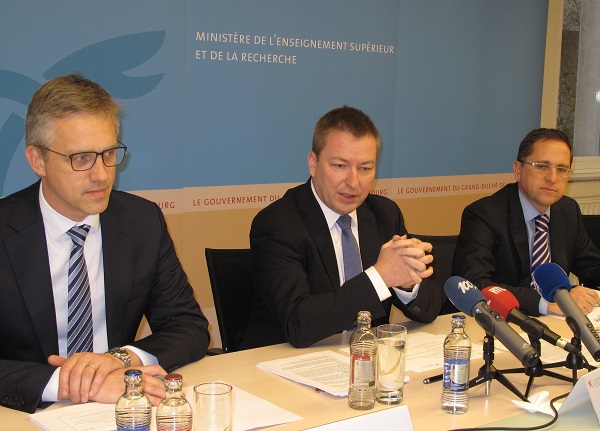 (L-R): Gaston Schmit, first government adviser; Marc Hansen, Minister Delegate for Higher Education and Research; Léon Diederich, first government adviser;
Credit: MESR
(L-R): Gaston Schmit, first government adviser; Marc Hansen, Minister Delegate for Higher Education and Research; Léon Diederich, first government adviser;
Credit: MESR
On 11 January 2018, Luxembourg's Minister for Higher Education and Research, Marc Hansen, presented details of the contract with the University of Luxembourg and the multi-year agreements with the Luxembourg Institute of Science and Technology (LIST), the Luxembourg Institute of Health (LIH) and Luxembourg Institute of Socio-Economic Research (LISER) as well as the FNR (National Research Fund), for the years 2018 to 2021.
The establishment contract of the University of Luxembourg and the multiannual public research centres LIST, LIH, LISER and the FNR have been negotiated in parallel, so that greater coherence between contracts of different actors, with identical definitions of objectives and indicators.
During the period from 2018 to 2021, the state will invest €1.44 billion in research and higher education. €766.8 million will be allocated to the University of Luxembourg and €383 million to the three public research centres LIST, LIH and LISER. In addition, €265.4 million will be allocated to programmes and instruments of the National Research Fund. A bonus of €20.5 million will reward the performance of institutions in the European Union's Framework Programme for Research and Development.
The State's financial resources for research and higher education thus grew by €284 million euros, corresponding to an increase of 25% over the period from 2014 to 2017.
These agreements set the state's endowment for these institutions in exchange for a series of objectives to be achieved. Laws establishing or organising public public research institutions stipulate that relations between the State and these institutions are governed by four-year multi-year agreements, which determine the resources and staffing required for the implementation of public research. implementation of the activities of the institutions and define the financial commitments of the State on the one hand and the objectives to be achieved by the institutions, which are reflected in terms of indicators relating to:
• Scientific excellence, such as income from the programs of the NRF or Horizon 2020 European Union Research and Development Framework Programme, or articles in high-level scientific journals, European Research Council Fellowships;
• socio-economic valuation, such as revenue from collaboration with companies and ministries / administrations, the number of patents, licenses, spin-offs, or doctoral and post-docs in public-private partnerships;
• strengthened collaboration between the institutions, translated by the number of joint scientific publications (Uni - CRP), as well as joint doctoral training and joint and affiliated professors;
• education and training, such as the number of PhDs, student mobility, or accreditation of training.








